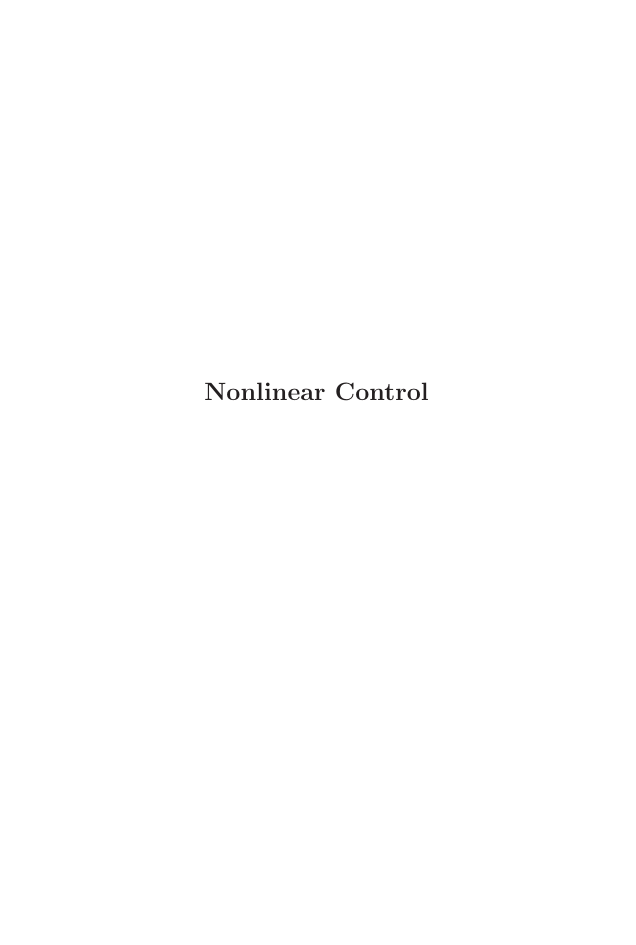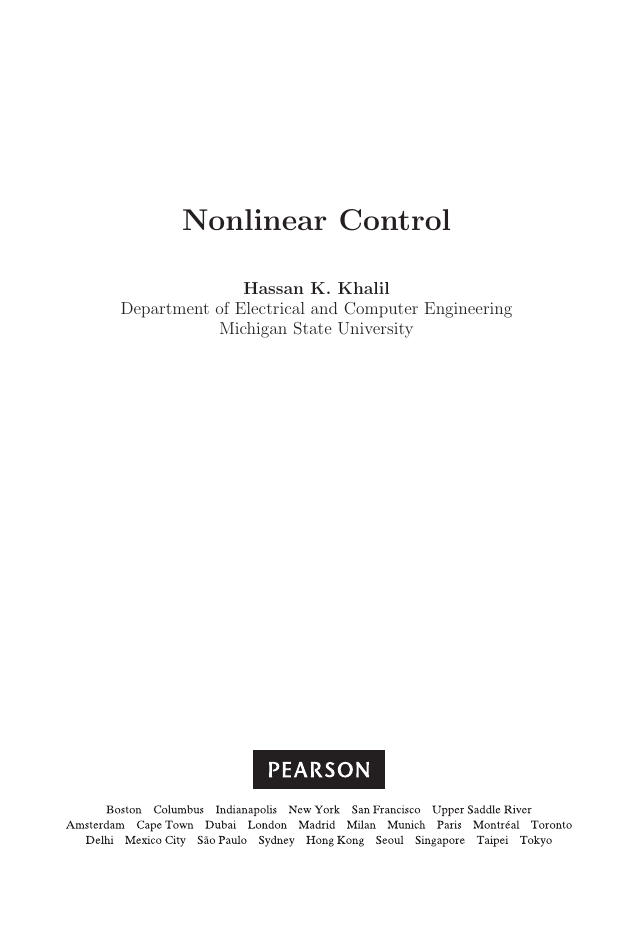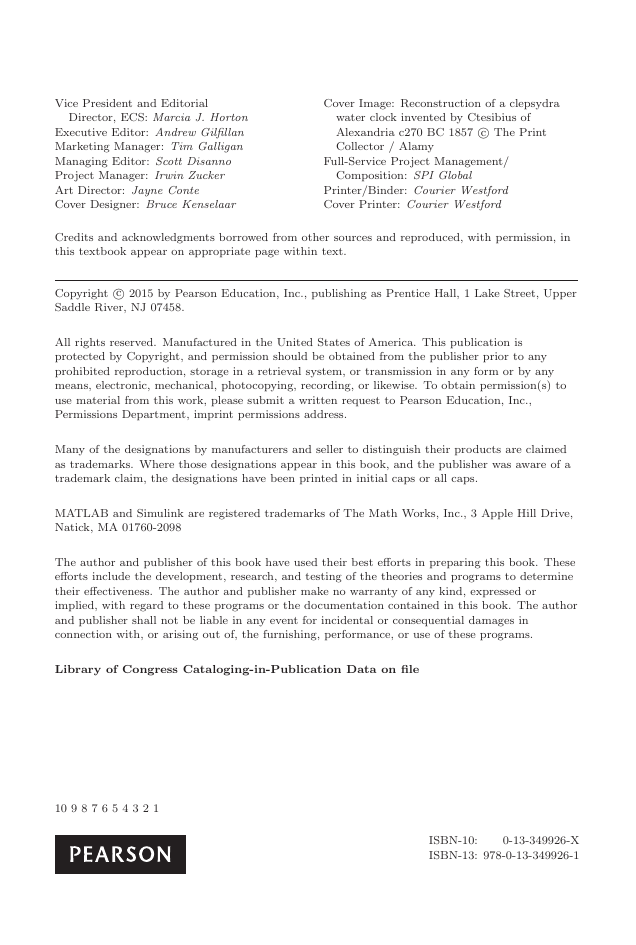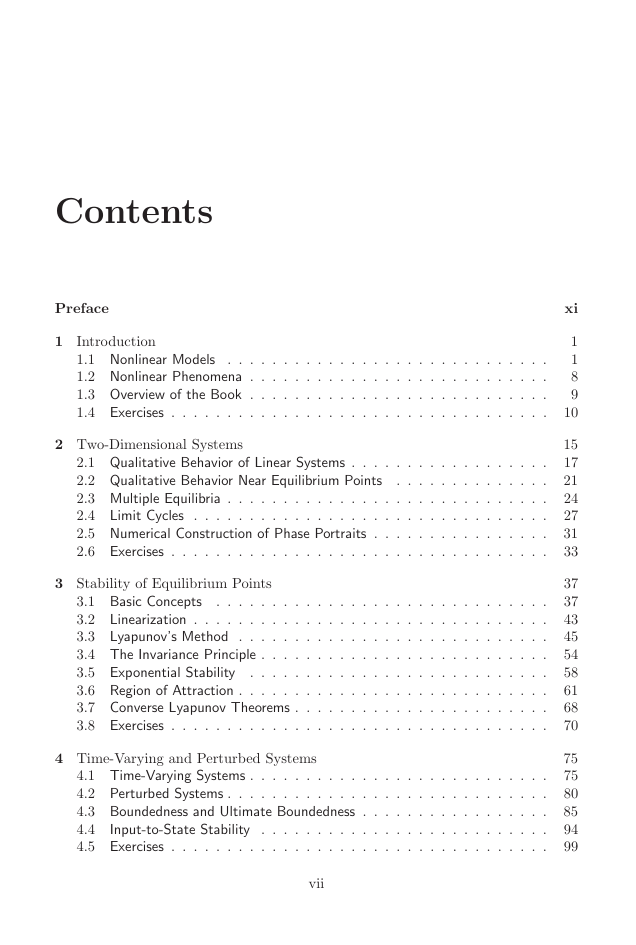Cover
Title Page
Copyright Page
Contents
Preface
1 Introduction
1.1 Nonlinear Models
1.2 Nonlinear Phenomena
1.3 Overview of the Book
1.4 Exercises
2 Two-Dimensional Systems
2.1 Qualitative Behavior of Linear Systems
2.2 Qualitative Behavior Near Equilibrium Points
2.3 Multiple Equilibria
2.4 Limit Cycles
2.5 Numerical Construction of Phase Portraits
2.6 Exercises
3 Stability of Equilibrium Points
3.1 Basic Concepts
3.2 Linearization
3.3 Lyapunov’s Method
3.4 The Invariance Principle
3.5 Exponential Stability
3.6 Region of Attraction
3.7 Converse Lyapunov Theorems
3.8 Exercises
4 Time-Varying and Perturbed Systems
4.1 Time-Varying Systems
4.2 Perturbed Systems
4.3 Boundedness and Ultimate Boundedness
4.4 Input-to-State Stability
4.5 Exercises
5 Passivity
5.1 Memoryless Functions
5.2 State Models
5.3 Positive Real Transfer Functions
5.4 Connection with Stability
5.5 Exercises
6 Input-Output Stability
6.1 L Stability
6.2 L Stability of State Models
6.3 L[sub(2)] Gain
6.4 Exercises
7 Stability of Feedback Systems
7.1 Passivity Theorems
7.2 The Small-Gain Theorem
7.3 Absolute Stability
7.3.1 Circle Criterion
7.3.2 Popov Criterion
7.4 Exercises
8 Special Nonlinear Forms
8.1 Normal Form
8.2 Controller Form
8.3 Observer Form
8.4 Exercises
9 State Feedback Stabilization
9.1 Basic Concepts
9.2 Linearization
9.3 Feedback Linearization
9.4 Partial Feedback Linearization
9.5 Backstepping
9.6 Passivity-Based Control
9.7 Control Lyapunov Functions
9.8 Exercises
10 Robust State Feedback Stabilization
10.1 Sliding Mode Control
10.2 Lyapunov Redesign
10.3 High-Gain Feedback
10.4 Exercises
11 Nonlinear Observers
11.1 Local Observers
11.2 The Extended Kalman Filter
11.3 Global Observers
11.4 High-Gain Observers
11.5 Exercises
12 Output Feedback Stabilization
12.1 Linearization
12.2 Passivity-Based Control
12.3 Observer-Based Control
12.4 High-Gain Observers and the Separation Principle
12.5 Robust Stabilization of Minimum Phase Systems
12.5.1 Relative Degree One
12.5.2 Relative Degree Higher Than One
12.6 Exercises
13 Tracking and Regulation
13.1 Tracking
13.2 Robust Tracking
13.3 Transition Between Set Points
13.4 Robust Regulation via Integral Action
13.5 Output Feedback
13.6 Exercises
A: Examples
A.1 Pendulum
A.2 Mass–Spring System
A.3 Tunnel-Diode Circuit
A.4 Negative-Resistance Oscillator
A.5 DC-to-DC Power Converter
A.6 Biochemical Reactor
A.7 DC Motor
A.8 Magnetic Levitation
A.9 Electrostatic Microactuator
A.10 Robot Manipulator
A.11 Inverted Pendulum on a Cart
A.12 Translational Oscillator with Rotating Actuator
B: Mathematical Review
C: Composite Lyapunov Functions
C.1 Cascade Systems
C.2 Interconnected Systems
C.3 Singularly Perturbed Systems
D: Proofs
Bibliography
Symbols
Index
A
B
C
D
E
F
G
H
I
J
K
L
M
N
O
P
Q
R
S
T
U
V
W
Z
















 2023年江西萍乡中考道德与法治真题及答案.doc
2023年江西萍乡中考道德与法治真题及答案.doc 2012年重庆南川中考生物真题及答案.doc
2012年重庆南川中考生物真题及答案.doc 2013年江西师范大学地理学综合及文艺理论基础考研真题.doc
2013年江西师范大学地理学综合及文艺理论基础考研真题.doc 2020年四川甘孜小升初语文真题及答案I卷.doc
2020年四川甘孜小升初语文真题及答案I卷.doc 2020年注册岩土工程师专业基础考试真题及答案.doc
2020年注册岩土工程师专业基础考试真题及答案.doc 2023-2024学年福建省厦门市九年级上学期数学月考试题及答案.doc
2023-2024学年福建省厦门市九年级上学期数学月考试题及答案.doc 2021-2022学年辽宁省沈阳市大东区九年级上学期语文期末试题及答案.doc
2021-2022学年辽宁省沈阳市大东区九年级上学期语文期末试题及答案.doc 2022-2023学年北京东城区初三第一学期物理期末试卷及答案.doc
2022-2023学年北京东城区初三第一学期物理期末试卷及答案.doc 2018上半年江西教师资格初中地理学科知识与教学能力真题及答案.doc
2018上半年江西教师资格初中地理学科知识与教学能力真题及答案.doc 2012年河北国家公务员申论考试真题及答案-省级.doc
2012年河北国家公务员申论考试真题及答案-省级.doc 2020-2021学年江苏省扬州市江都区邵樊片九年级上学期数学第一次质量检测试题及答案.doc
2020-2021学年江苏省扬州市江都区邵樊片九年级上学期数学第一次质量检测试题及答案.doc 2022下半年黑龙江教师资格证中学综合素质真题及答案.doc
2022下半年黑龙江教师资格证中学综合素质真题及答案.doc